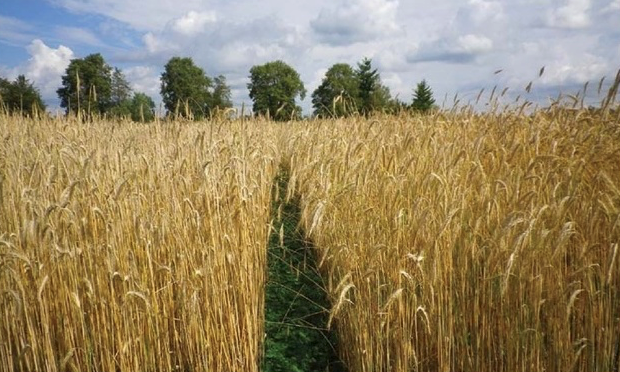What is organic production? How does it support biodiversity?
Organic production is an agricultural method that takes into account the principles of the natural matter cycle for the production of food and other agricultural products [1]. In crop production, the aim of organic production is to maintain soil fertility by using only organic fertilisers, natural plant protection products, and non-genetically modified organisms. In animal husbandry, animal welfare, the avoidance of growth hormones, and the keeping of the number of animals in balance with the size of agricultural land are considered important [2].
The abundance of species and their habitats is important for biodiversity [3]. Organic agricultural land has, on average, 30% more species and 50% more specimens than conventional agricultural land [4]. It also has a positive effect on the surrounding areas. At the same time, organic fields generally have lower yields, so more arable land needs to be cultivated to get the same amount of food. Unfortunately, as much as 25–30% of the food produced is thrown away by humankind [15].
Organic products have evolved from a previous niche product into a consumer product. Organic production could feed the world’s population if we reduced wasting and gradually decreased the amount of animal protein in food. As it is difficult to change consumer habits, the transition to organic production can only be partial and time-consuming [5].
In 2020, more than 22% of arable land in Estonia was organic [6], of which approximately 2/3 was used for feed crops and permanent grasslands [7]. The bottlenecks in organic production are the lack of a large-scale processing industry specialising in organic production, low yields and efficiency, and high own cost [8] – which is why it is not realistic to make all agricultural land organic in Estonia in the near future.
Organic foods are healthy: they usually have higher nutrient levels than conventional foods and no residues of toxic plant protection products [9, 10, 11, 12].
Several guidelines have been issued for engaging in organic farming. One of these is the basics of organic farming, which provides information on fertilisation, sowing, and plant protection products [13]. Those who are interested in organic farming can apply for several sectoral grants through the ARIB [14].

Last modified: 12.01.2022
__________________________________________________
[1] European Commission. Organic farming. https://ec.europa.eu/info/food-farming-fisheries/farming/organic-farming/organics-glance_en.
[2] Eesti Mahepõllumajanduse Sihtasutus. Mahepõllumajandus Eestis. Põllumajandusministeerium, 2009.
[3] M. Pärtel, A. Helm, E. Roosaluste, M. Zobel. Bioloogiline mitmekesisus Eesti pool-looduslikes ökosüsteemides. – Keskkonna nüüdisprobleeme (toim J-M. Punning). Tartu, Tartu Ülikooli Ökoloogia ja Maateatuste instituut, 2007, lk 223–302.
[4] J. Bengtsson, J. Ahnström, A. C. Weibull. The effects of organic agriculture on biodiversity and abundance: a meta-analysis. Journal of Applied Ecology, 42/2005: 261-269. https://besjournals.onlinelibrary.wiley.com/doi/pdf/10.1111/j.1365-2664.2005.01005.x.
[5] A. Muller, C. Schader, N-E-H. Schialabba, et al.. Strategies for feeding the word more sustainably with organic agriculture. Nature Communications, 8/2017, 1290. https://www.nature.com/articles/s41467-017-01410-w.pdf.
[6] A. Vetemaa, M. Mikk, E. Peetsmann. Mahepõllumajandus Eestis. 2021: http://www.maheklubi.ee/upload/Editor/mahe_eestis_2020.pdf
[7] E. Kirs. Kui mahe on Eestimaa? Statistikablogi, 2009. https://www.stat.ee/et/uudised/2019/08/14/kui-mahe-on-eestimaa.
[8] T. Kevvai. Mahepõllumajanduse arenguperspektiivid Eestis. Konverentsi “Eesti mahepõllumajandus täna ja tulevikus 20.11.2014” ettekanne. http://mahekeskus.emu.ee/syndmused/mahekonverents-2014/.
[9] C. M. Kennedy, E. Lonsdorf, M. C. Neel, N. M. Williams, T. H. Ricketts, R. Winfree, et al. A. global quantitative synthesis of local and landscape effects on wild bee pollinators in agroecosystems. Ecol Lett, 2013/16, 584–599.
[10] S. L. Tuck, C. Winqvist, F. Mota, J. Ahnström, L. A. Turnbull, J. Bengtsson. Land-use intensity and the effects of organic farming on biodiversity: a hierarchical meta-analysis. J Appl Ecol, 2014/51, 746–755.
[11] J. P. Reganold, J. M. Wachter. Organic agriculture in the twenty-first century. Nat Plants, 2016/2, 15–221.
[12] A. Kovács-Hostyánszki, A. Espíndola, A. J. Vanbergen, J. Settele, C. Kremen, L. V. Dicks, L. V. Ecological intensification to mitigate impacts of conventional intensive land use on pollinators and pollination. Ecol Lett. 2017/20, 673–689.
[13] L-B. Carlsson et al. Mahepõllumajanduse alused. Põllumajandusministeerium, 2017. http://www.maheklubi.ee/upload/Editor/New%20Folder/mahepollumajanduse_alused.pdf.
[14] Põllumajanduse Registrite ja Informatsiooni Amet (PRIA), 2020. Toetused: https://www.pria.ee/toetused.
[15] ÜRO Rahvusvahelise Kliimamuutuste Paneeli (IPCC) 2019. aasta aruanne: https://www.ipcc.ch/site/assets/uploads/sites/4/2020/02/SPM_Updated-Jan20.pdf.